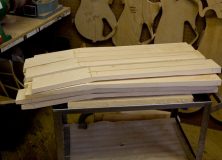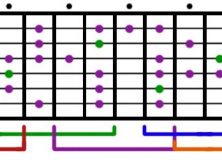
Read Time 5 Minutes
Taking Your Blues Playing from “Meh” to Mind-Blowing
Hey there, fellow guitar nerds! Today we’re diving into something you probably already know a bit about – the blues scale – but we’re going to explore how to make it really speak, sing, and maybe even make someone cry (in a good way).
If you’re like me, you learned the blues scale patterns early on, noodled around with them, and thought “cool, I can improvise now!” But then you heard players like B.B. King, Stevie Ray Vaughan, or John Mayer take those same six notes and somehow make them tell entire stories. So what gives?
The secret isn’t in knowing more scales – it’s in how you play the notes you already know. Let’s break this down.
The Blues Scale: A Quick Refresher
Just so we’re on the same page, the blues scale is your regular minor pentatonic with an added blue note (the diminished 5th or ♭5). In A minor, that’s:
A minor blues scale: A, C, D, E♭, E, G, A
But you probably knew that already. The magic happens in what comes next.
Technique #1: Bend With Intention
The difference between an amateur bend and a pro bend isn’t strength – it’s control and intention. Try these approaches:
- The Emotional Half-Step Bend: Especially effective when bending from the 4th to the flat 5th in the blues scale. Don’t just bend – approach it softly, bend slowly, and give it a slight vibrato at the top. This creates tension that feels unresolved and emotional.
- The Confident Full-Step Bend: When bending from the 4th to the 5th (like D to E in A minor blues), don’t rush it. Start slower and accelerate slightly as you reach the target note. This creates a sense of confidence and resolution.
- The Pre-Bend Surprise: Start with the string already bent up, then pick and release slowly. This creates a vocal-like effect that catches listeners off guard – like someone sighing or exhaling emotion.
Remember, it’s not about how many bends you do – it’s about making each one count. One perfectly executed, emotionally timed bend is worth more than twenty generic ones.
Technique #2: Vibrato That Speaks
Your vibrato says more about your playing personality than almost any other technique. Here are three vibrato styles to experiment with:
- The B.B. King Butterfly: A wide, pronounced vibrato that comes from rotating your wrist (not just moving your fingers). This vibrato sings and commands attention – perfect for when you want a note to really stand out.
- The Subtle Pulse: A gentler, narrower vibrato that adds just a hint of movement. Great for building phrases where you don’t want every note to scream for attention.
- The Slow Burn: Start with no vibrato, then gradually introduce it and widen it. This creates a sense of growing emotion, like someone becoming more passionate as they speak.
Try playing the same lick three times with each of these vibrato styles. You’ll be amazed at how differently they come across!
Technique #3: Dynamics Are Your Secret Weapon
Most intermediate players completely overlook this: how hard or soft you pick completely changes the emotional impact of a note. Within the blues scale, try this exercise:
- Play the first note of your phrase loudly
- Play the next few notes softly
- Gradually build up again toward your target note
This simple dynamic shape creates narrative tension that makes people actually want to listen to what you’re playing. It’s the difference between someone speaking in a monotone voice versus someone who knows when to whisper and when to raise their voice for emphasis.
Genre Examples: Same Scale, Different Vibes
Let’s see how these techniques apply across different genres:
Classic Blues (Think B.B. King):
Focus on space between notes, pronounced vibrato, and vocal-like bends. Try targeting the 5th and flat 7th of the scale with confident bends. Less is more here – make every note count.
Try this lick in A minor blues:
- Bend the D (8th fret, G string) slowly up to E
- Hold it with a wide vibrato
- Release to D
- Pull off to C (8th fret, D string)
- Resolve to A with a gentle touch
Rock (Think Slash or Gary Moore):
Combine faster passages with dramatic held notes. Use more aggressive picking, but still maintain dynamic control. The contrast between fast runs and sustained bends creates that classic rock tension and release.
Try this in A minor blues:
- Quick hammer-on from A to C on the G string
- Hit the E♭ (blues note) briefly
- Bend the D on the G string aggressively to E and hold with intense vibrato
- Release and play a faster descending run using the scale
Country (Think Albert Lee):
Incorporate double-stops (playing two notes together) within the blues scale. Combine quick, precise bends with snappy releases. The “chicken pickin'” technique works great with blues scale patterns.
Try this in A minor blues:
- Play the A and C notes together as a double stop
- Do a quick “cluck” technique by muting right after playing
- Bend the D to E♭ with a country-style quick vibrato
- Release and resolve to A with a picked ghost note in between
Jazz Fusion (Think Robben Ford):
Mix the blues scale with passing chromatic notes. Use a smoother, more legato approach with less pronounced vibrato. Try starting phrases on unexpected notes of the scale.
Try this in A minor blues:
- Start on the C note with a soft attack
- Slide chromatically up to D
- Play E♭ to E natural as a quick melodic motion
- Resolve to G with a subtle vibrato
- Add a chromatic approach note before resolving to A
Putting It All Together: The Emotional Roadmap
The most expressive blues players create an emotional journey. Here’s a simple framework:
- Start conversational: Begin with simpler, cleaner phrases with minimal effects
- Build tension: Gradually incorporate more expressive bends and vibrato
- Create a high point: Use your most dramatic technique (big bend, wide vibrato) at the emotional peak
- Resolve thoughtfully: Bring it back down with softer dynamics and more space
Think of it like telling a story – you need quiet moments and exciting moments to keep people engaged.
Final Thoughts
Remember, the blues scale is just a framework – it’s what you do with those six notes that matters. The most impactful blues players in history often played fewer notes than their contemporaries, but they made each one count through emotional techniques like the ones we’ve covered.
Next time you pick up your guitar to jam on the blues scale, focus less on where your fingers are going and more on how each note feels. Are you just playing notes, or are you saying something with them?
Try recording yourself playing the same simple blues lick three different ways, focusing on different emotional approaches. Listen back and ask yourself – which one would make you stop and pay attention if you heard another guitarist play it?
That’s where the magic happens. Not in your fingers, but in the ears and hearts of whoever’s listening.





